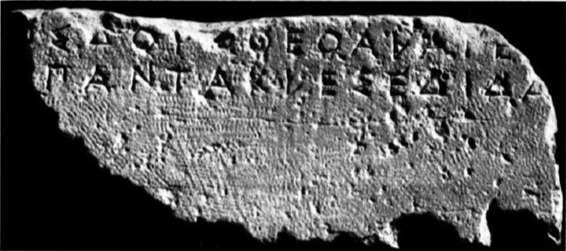[Lemma] Athens, in the vicinity of the choregic monument of Lysicrates. Fragment of a quadrangular base, the upper surface of which is preserved intact (Amandry), bearing on one of its sides an inscription—unfortunately incomplete—whose letters are arranged in stoichedon style.
From a palaeographic perspective, the alphabet employed may be characterised as ‘light blue’. Notable features include the use of a Chalcidian lambda, and an epsilon composed of three horizontal, parallel strokes of equal length, employed to denote both the short and long vocal /e/. Also of note are: alpha with a horizontal internal bar; delta shaped as an isosceles triangle; theta marked by a central dot; ny with external strokes extended — one downward, the other upward — ; omikron equal in size to the surrounding letters; hooked pi; and four stroked sigma.
According to Amandry’s suggestion, the text was likely distributed over only two lines of writing.
[Typology]
[Period] 450–400 BC (more precisely 430-420 BC, on the basis of paleography, see Meritt 1967)
[Text]
[- – -]ος Δοροθέō Ἁλαιε[ὺς ἐχορέγε – – -]
[- – -] Παντακλε̑ς ἐδίδα[σκε – – -]
vacat
[Critical apparatus]
[Κεκροπὶς s. Αἰγεὶς ἐνίκα – -] IG I2 (ipotizzando, a torto, l’esistenza di una prima linea non conservata)
l.1: – ca 8 – -ος Δοροθέο Ἁλαιε[ὺς ἐχορέγει] IG I2 │ – – -ος Δοροθέο Ἁλαιε[ὺς ἐχορέγε, Αἰγεῒς ἐνίκα] IG I3│[χορεγõντ]ος Δοροθέο Ἁλαιέ[ος‧ Αἰγεὶς ἐνίκα‧] Meritt
l.2: Παντακλε͂ς ἐδίδα[σκε]. IG I2; Meritt │- – – Παντακλε͂ς ἐδίδα[σκε – – -] IG I3
[Translation]
[- – -]os son of Dorotheos of the deme of Halai [was the choregus– – -]
[- – -] Pantakles was the chorus master [- – -]
[Comment]
Only the final two letters—omikron and sigma— of the name of the choregos are preserved. Dorotheos, as clearly explained by Amandry and Ieranò in their critiques of the restoration proposals in IG I², IG I³ and Meritt 1967 (all cited in the critical apparatus), should be interpreted as a patronymic, followed by the demotic (Halaieus), which is to be restored in the nominative case, as it refers to the name of the choregos.
The name of the didaskalos, Pantakles, is preserved, a figure known to the tradition (see Meritt 1967). The attribution of the inscription to the Thargelia is due to Amandry 1977 and followed by Ieranò 1997: “la menzione completa, con tanto di patronimico e demotico, del nome del corego induce ad attribuire l’iscrizione ai titoli coregici delle Targelie, dove la figura del corego è sempre dominante”.
Owing to the lacunae, the names of the two tribes and the type of chorus are missing. IG I², IG I³ and Meritt 1967, by contrast, assigned the dedication to the Dionysia. In doing so, Meritt interpreted Dorotheos as the name of the choregos, hypothesizing that it constituted the second element of an absolute genitive construction, [χορεγο͂ντ]ος Δοροθέο, for which there are no known parallels and which appears highly irregular when compared with established epigraphic formulae (Amandry 1967, Ieranò 1997). Meritt also proposed a possible connection with the Aigeis tribe.
The transcription offered here is based on Amandry’s edition, modified only slightly to conform to the use of diacritics of the Leiden system.
[Documentation]
It is here reproduced the photo in AMANDRY 1977, 184, fig. 9.

[Reference Edition]
P. AMANDRY, ‘Trépieds d’Athènes: II. Thargélies’, BCH 101, 1977, 183-185.
[Essential Bibliography]
IG I 337; Syll.3 1081; IG I2 771; IG I3 959; E. REISCH, De musicis Graecorum certaminibus, Diss., Wien 1885, 31; B.D. MERITT, ‘The Choregic Dedication of Leagros’, GRBS 7, 1967, 46-47; G. IERANÒ, Il ditirambo di Dioniso. Le testimonianze antiche, Pisa-Roma 1997, 354-355, nr. 66.
[Keywords]
Athens, Thargelia, choregic dedications, Dorotheos, deme of Halai, Pantakles
[Giovanni Boffa]







